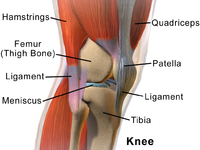
Photo from wikipedia
Background The EQ-5D-5 L is a quality-of-life questionnaire based on individuals’ preferences that is widely employed for cost-effectiveness analysis. Given the current demand for mapping algorithms to directly assign “utilities”, this… Click to show full abstract
Background The EQ-5D-5 L is a quality-of-life questionnaire based on individuals’ preferences that is widely employed for cost-effectiveness analysis. Given the current demand for mapping algorithms to directly assign “utilities”, this study aimed to generate different mapping models for predicting EQ-5D-5 L utility values based on scores of the Oxford Hip Score (OHS) and Oxford Knee Score (OKS) questionnaires provided by patients suffering from hip and knee osteoarthritis (OA), respectively, and to assess the predictive capability of these functions. Methods This was a prospective, observational study. Following the criteria of the American Rheumatism Association, 361 patients with hip OA and 397 with knee OA from three regions in Spain were included. Health-related quality of life (HRQoL) was assessed through the EQ-5D-5 L general questionnaire and the OHS and OKS specifically for lower limb OA. Based on the scores on the OHS and OKS questionnaires, EQ-5D-5 L utilities were estimated using 4 models: ordinary least squares (OLS), Tobit, generalized linear model (GLM), and beta regression (Breg). The models were validated on the same patients after 6 months: the mean absolute error (MAE) and mean squared error (MSE) with their 95% confidence intervals (CI), mean values of standard errors (SE), intraclass correlation coefficients (ICC), and Bland-Altman plots were obtained. Results The lowest MAEs were obtained using GLM and Breg models, with values of 0.1103 (0.0993–0.1214) and 0.1229 (0.1102–0.1335) for hip OA, and values of 0.1127 (0.1014–0.1239) and 0.1141 (0.1031–0.1251) for knee OA. MSE values were also lower using GLM and Breg. ICCs between predicted and observed values were around or over the 0.8 cut-off point. Bland-Altman plots showed an acceptable correlation, but precision was lower for subjects with worse HRQoL, which was also evident when comparing MAEs of the bottom and top halves of the utilities scale. Predictive equations for utilities based on OHS/OKS scores were proposed. Conclusions The OHS and OKS scores allow for estimating EQ-5D-5 L utility indexes for patients with hip and knee OA, respectively, with adequate validity and precision. GLM and Breg produce the best predictions. The predictive power of proposed equations is more consistent for subjects in better health condition.
Journal Title: Health and Quality of Life Outcomes
Year Published: 2020
Link to full text (if available)
Share on Social Media: Sign Up to like & get
recommendations!